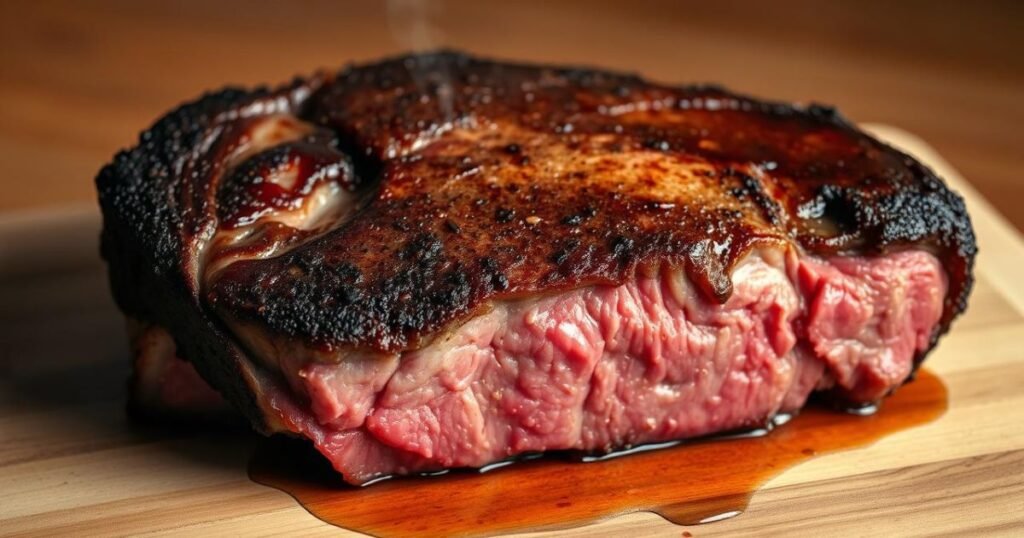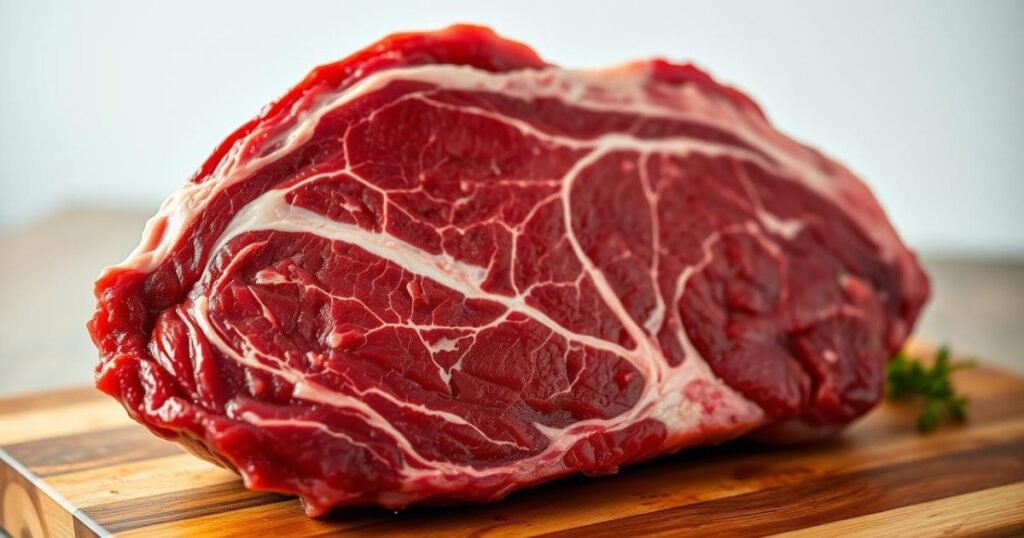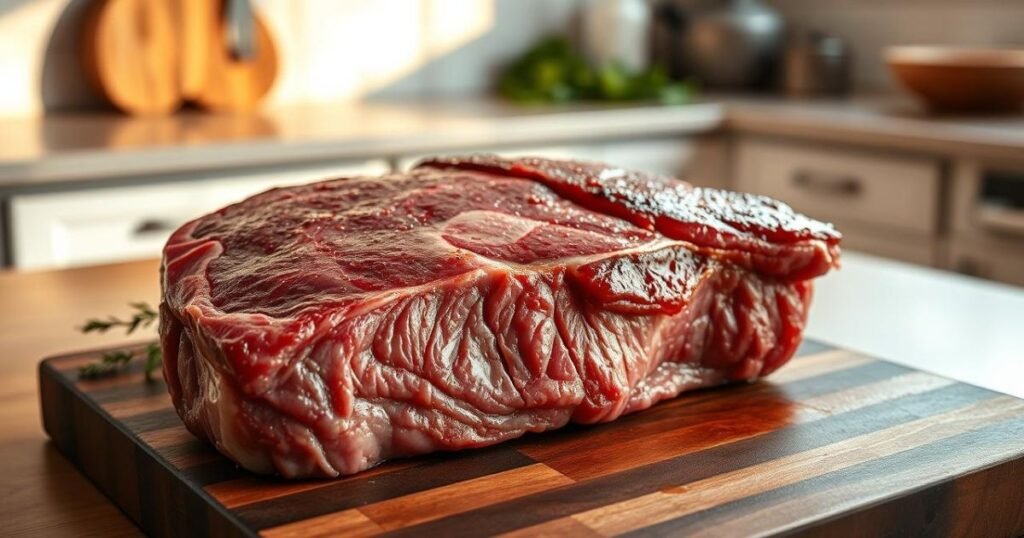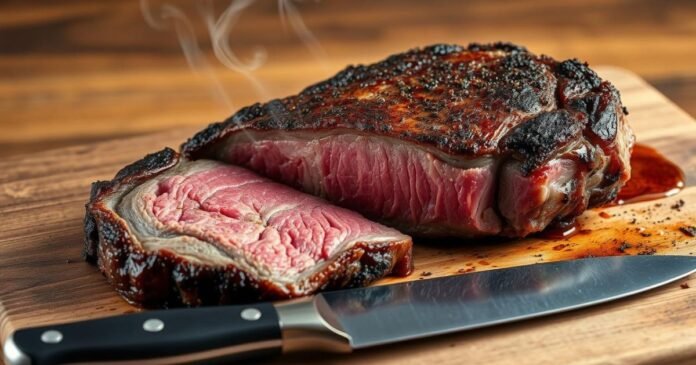Did you know less than 5% of beef is graded as Prime? This exclusive cut has the most marbling, making it the top choice for beef roasts. I’m excited to share my rib eye roast recipe that turns this premium cut into a mouthwatering masterpiece.
A well-prepared beef roast is a show-stopper at any dinner table. My roasted rib eye recipe transforms a 14-pound cut into 12 servings of pure culinary bliss. With just 15 minutes of prep and an hour of cook time, you’ll create a meal that rivals the finest steakhouses.
This prime rib recipe isn’t just about the end result. It’s a journey through the art of seasoning, searing, and slow-roasting. I’ll guide you through each step, from selecting the perfect cut to achieving that ideal internal temperature of 125°F for a mouthwatering medium-rare finish.
Get ready to elevate your cooking game with this foolproof rib eye roast recipe. It’s time to turn your kitchen into a gourmet haven and impress your guests with a roast that’s nothing short of spectacular.
Understanding Ribeye Roast vs Prime Rib
Ribeye roast and prime rib are two top cuts of beef. They both come from the rib section of the cow. But, they have different qualities that make them unique.
What Makes Ribeye Roast Special
Ribeye roast is known for its rich marbling and tender texture. It’s usually boneless, making it easy to slice and serve. The rib cap, or Spinalis Dorsi, is the most flavorful part of the roast.
Differences Between Cuts
Ribeye and prime rib come from the same area but differ in several ways:
- Ribeye is cut before cooking, while prime rib is the entire rib roast
- Prime rib often includes the bone, whereas ribeye is usually boneless
- Cooking methods differ: ribeye is grilled or seared, prime rib is slow-roasted
Choosing the Best Cut for Your Meal
For a special occasion, a bone-in prime rib (6-8 pounds) can serve 7-10 people. It’s perfect for oven roasted beef, taking about 15 minutes per pound at 325°F. Use a meat thermometer to achieve medium-rare (130-135°F). For a quicker meal, a ribeye roast is ideal. Regardless of your choice, a quality roasting pan is essential for even cooking.
| Cut | Weight | Cooking Time | Serving Size |
|---|---|---|---|
| Prime Rib | 6-8 lbs | 90-120 mins | 7-10 people |
| Ribeye Roast | 4-6 lbs | 60-90 mins | 4-6 people |

Essential Ingredients for a Rib Eye Roast Recipe
Creating the perfect rib eye roast beef recipe starts with choosing the right ingredients. I’ll guide you through selecting a top-notch beef ribeye roast and preparing a flavorful beef rub that will elevate your dish.
Selecting the Perfect Roast
When shopping for a beef ribeye roast, look for a cut with good marbling. This ensures a juicy, flavorful result. A 3-pound roast is ideal for serving a family of four with some leftovers. Remember, the quality of your meat greatly impacts the final dish.
Garlic Butter Mixture Components
To enhance the flavor of your rib eye roast beef recipe, prepare a garlic butter mixture. You’ll need:
- 1/2 cup softened butter
- 4 minced garlic cloves
- 1 tablespoon fresh rosemary, chopped
- 1 tablespoon fresh thyme, chopped
Dry Rub Seasonings
A good beef rub is key for a delicious crust. Mix these ingredients for a perfect dry rub:
- 2 tablespoons kosher salt
- 1 tablespoon black pepper
- 1 tablespoon paprika
- 1 teaspoon garlic powder
- 1 teaspoon onion powder
- 1 tablespoon brown sugar (optional, for caramelization)
This beef rub will create a flavorful crust on your roast. If you prefer a beef marinade, mix these spices with olive oil and lemon juice. Either way, your rib eye roast beef recipe will be bursting with flavor.
Preparation and Seasoning Techniques
Preparing a bone in ribeye roast or boneless ribeye roast is easier than you might think. I start by patting the meat dry with paper towels. This step is key for a perfect crust when cooking the ribeye roast.
Next, I make a flavorful garlic butter mixture. I mix softened butter with minced garlic, herbs, and a bit of lemon zest. This mixture adds flavor and helps the seasonings stick to the meat.
For the dry rub, I use a mix of salt, black pepper, and other seasonings like rosemary and thyme. I apply this mixture all over the roast, covering every inch. This step is essential for a flavorful ribeye roast recipe.
Before cooking, I let the seasoned roast sit at room temperature for about an hour. This ensures even cooking. For a 5-pound roast, I cook it for about 100 minutes at 325°F after a 15-minute sear at 450°F.
Remember, the cooking process doesn’t end when you take the roast out of the oven. Letting it rest for 30 minutes allows the juices to redistribute. This results in a perfectly juicy ribeye roast.

Step-by-Step Cooking Instructions
Learning to cook a perfect ribeye roast recipe needs focus and timing. I’ll show you how to get that delicious medium rare beef you want.
Bringing Meat to Room Temperature
First, take your ribeye roast out of the fridge 2 hours before cooking. This helps it cook evenly.
Initial High-Heat Searing
Heat your oven to 500°F. Put the roast in for 15 minutes to get a tasty crust. This step keeps the juices inside, making it perfect for medium rare.
Slow Roasting Process
After searing, lower the oven to 325°F. Roast for about 20 minutes per pound. A 5-pound roast will cook for about 1.5 hours.
Resting and Slicing Guidelines
Take the roast out when it’s between 115°F and 120°F for medium rare. Let it rest for 20 minutes before slicing. This way, it will be juicy and pink in the middle.
| Doneness | Remove at | Final Temp |
|---|---|---|
| Rare | 120°F | 125-130°F |
| Medium Rare | 130°F | 135-140°F |
| Medium | 140°F | 145-150°F |
Cook times can change based on your oven and roast size. Always use a meat thermometer for the best results.
Perfect Temperature Guide and Cooking Times
Getting the perfect prime rib roast needs careful attention to temperature and timing. I’ll show you how to cook this tasty cut just right.
Internal Temperature Chart
For a delicious medium-rare prime rib, aim for an internal temperature of 125°F (52°C). If you like it medium, cook it until it reaches 130°F (54°C). Remember, the temperature will go up 5-8°F while it rests.
| Doneness | Pull Temperature | Final Temperature |
|---|---|---|
| Medium-Rare | 125°F (52°C) | 130-134°F (55-57°C) |
| Medium | 130°F (54°C) | 135-140°F (58-60°C) |
Cooking Duration by Weight
After searing, roast your prime rib at 225°F (107°C). Cook it for 20 minutes per pound. A 3-pound roast cooks for about 60 minutes, and a 6-pound roast takes around 120 minutes.
Using a Meat Thermometer
A good meat thermometer is key for perfect results. Put it in the thickest part of the roast, avoiding fat or bone. Check multiple spots for accuracy. Don’t forget the 30-minute rest time, where the temperature keeps rising.
Remember, your garlic butter-basted prime rib roast needs an initial 15 minutes of high-heat searing before slow roasting starts. This method gives you a juicy inside and a flavorful crust.

Conclusion
I’ve shared the key steps to make a delicious standing rib roast. Choosing the right cut and reaching the perfect internal temperature are key. It’s important to let the meat come to room temperature before cooking for even heat.
Cooking times depend on the roast’s size and how done you like it. A 3-pound roast cooks in about 60 minutes, while a 6-pound one takes around 120 minutes. For a medium-rare, aim for 130-135°F. Always let the roast rest for 10-15 minutes before slicing.
By following these tips, you’ll learn to cook a juicy, flavorful ribeye roast. It’s perfect for dinner parties or a special treat. Try different seasonings and cooking methods to make it your own. Soon, you’ll be serving amazing ribeye roasts from your kitchen.
FAQ – Ribeye Roast Recipe
What’s the difference between a ribeye roast and prime rib?
A ribeye roast is smaller and boneless, coming from the same cow section as prime rib. Prime rib is larger and has a bone. Ribeye roast is cheaper and simpler to cook, perfect for home cooks.
How long should I let my ribeye roast come to room temperature before cooking?
Let your ribeye roast sit at room temperature for 1-2 hours before cooking. This ensures it cooks evenly.
What’s the best way to season a ribeye roast?
Season with a garlic butter mix and a dry rub. The garlic butter adds flavor and helps seasonings stick. The dry rub creates a tasty crust. Use salt, pepper, garlic, rosemary, and thyme.
What internal temperature should I aim for when cooking a ribeye roast?
For medium-rare, aim for 135°F (57°C) internal temperature. The temperature will rise 5-10°F during resting. Use a meat thermometer for accuracy.
How long should I cook my ribeye roast?
Cooking time varies by roast size and desired doneness. Cook at 325°F (163°C) for about 20 minutes per pound for medium-rare. Start with a 15-minute sear at 450°F (232°C).
Should I cover my ribeye roast while cooking?
No, don’t cover the roast. Uncovered cooking promotes better browning and crust.
How long should I let the ribeye roast rest after cooking?
Let the roast rest for 15-20 minutes after cooking. This redistributes juices for a juicy and flavorful result.
Can I use a boneless ribeye roast for this recipe?
Absolutely! Both bone-in and boneless roasts work well. Boneless roasts cook faster, so adjust cooking time.
What’s the best way to slice a ribeye roast?
Slice against the grain for tenderness. Use a sharp knife for 1/2 inch thick slices.
Can I prepare the ribeye roast in advance?
Season the roast up to 24 hours in advance and refrigerate. Bring it to room temperature before cooking.

Rib Eye Roast Recipe
Ingredients
- Garlic Butter Mixture:
- 1/2 cup softened butter
- 4 minced garlic cloves
- 1 tablespoon fresh rosemary chopped
- 1 tablespoon fresh thyme chopped
- Dry Rub Seasonings:
- 2 tablespoons kosher salt
- 1 tablespoon black pepper
- 1 tablespoon paprika
- 1 teaspoon garlic powder
- 1 teaspoon onion powder
- 1 tablespoon brown sugar optional, for caramelization
Instructions
- Take the ribeye roast out of the fridge 2 hours before cooking to bring it to room temperature.
- Preheat the oven to 500°F.
- Pat the roast dry with paper towels to ensure a perfect crust.
- Mix the garlic butter ingredients and rub them all over the roast.
- Prepare the dry rub seasonings and coat the roast evenly with the rub.
- Let the roast sit at room temperature for 1 hour.
- Sear the roast in the preheated oven for 15 minutes at 500°F.
- Lower the oven temperature to 325°F and slow-roast for about 20 minutes per pound.
- Use a meat thermometer to check for medium-rare (pull the roast at 120°F and rest to 130°F).
- Let the roast rest for 30 minutes before slicing.
Notes
- For medium-rare, aim for an internal temperature of 125°F before resting, which will increase to 130°F.
- The cooking time will vary based on the size of the roast and the desired doneness.
- Rest the roast for at least 30 minutes after removing it from the oven to redistribute juices.

